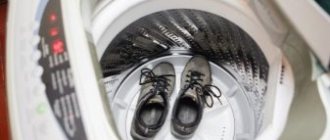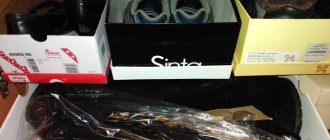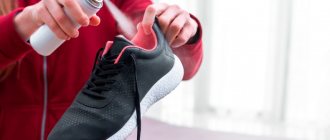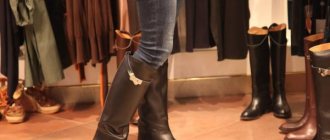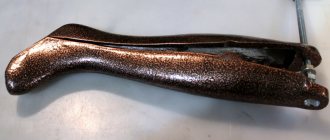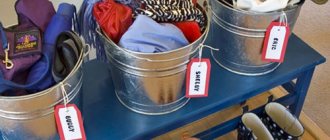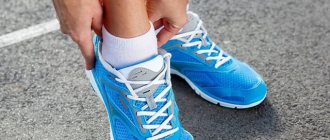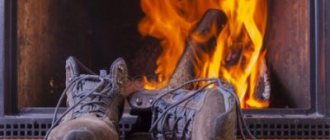The sole and outer covering of shoes most often do not tolerate moisture, unless we are talking about rubber boots. In other cases, wet boots or shoes need to be dried as quickly as possible and, most importantly, correctly. If you need to wash your sneakers and dry them quickly, these tips will also come in handy. Let's talk about the most important drying rules.
First steps if you get wet feet:
- If possible, remove your shoes immediately.
- Pull out the insoles, unlace them if they are sneakers or lace-up boots.
- Wash off dirt from the sole and outer part, gently soap and rinse with water.
- Don't forget about your feet. Wash them in warm water, dry them and put on woolen socks.
- If you have been walking in wet shoes for a long time, steam your feet in a bowl of hot water and drink hot ginger tea to prevent colds.
What can't you do?
What do we immediately think about when we need to dry wet boots? About hot batteries! After all, this is how you can completely dry your shoes in a couple of hours. And this is a big mistake.
Remember: never put wet steam on the battery! This is how you will ruin it the fastest. There will be streaks on the shoes, and the soles may come off. High temperatures are harmful to any coating except rubber. If you haven't ruined a pair of boots this way yet, then you're just lucky.
Attention! The microwave and oven are also not the best places to dry wet boots.
If your shoes get wet, be prepared for the fact that it will take a long time to dry - the whole night, and sometimes even more.
It is very important to dry correctly. Warm air is one option, but there should be no direct contact with it.
Drying boots or shoes is necessary in a well-ventilated room, or better yet, on a balcony or street.
What you should absolutely not do
To keep your shoes in good condition, you need to remember the following rules:
- Do not dry wet boots near the radiator or near other heating elements;
- You should not try to dry your shoes in the oven or microwave, the result will be disastrous;
- When using any electric dryers, you must ensure that the heating temperature is minimal;
- if you decide to dry your shoes with a hairdryer, do not use hot air, only cold air;
- Place only suitable sports shoes in the machine dryer;
- Do not attempt to clean wet suede boots.
Proper care and timely drying in reliable and proven ways will help protect your favorite shoes from various modifications. By thus extending the life of your shoes and boots, you will always look neat, tidy and, in addition, you will save money on buying new pairs.
Drying with heat and air
You can dry your shoes after washing using modern electrical appliances that we use at home.
Dryer with filler
If a pair is soaking wet, a shoe dryer will come in handy. It is inexpensive, for example, in Sportmaster you can buy a pair of such dryers for just 300 rubles. They are bags filled with an absorbent - silica gel. It absorbs moisture and helps quickly dry the pair from the inside. It is enough to place the product inside cleaned shoes from which the insoles have been removed.
Advice! Shoe insoles should be properly dried in natural conditions. Exposure to heat from the sun or heating devices is prohibited. Therefore, it is better to have 2 pairs, in case one gets wet.
You can dry your boots in this way in 5-6 hours.
After use, the absorbent bags can be dried in the sun or a radiator, and they are ready for use again.
Electric dryer
Probably one of the best ways to quickly dry shoes at home is to use an electric dryer. From 10 minutes to several hours - this is how long it will take to make the pair completely dry. Drying time depends on how wet the inside of your shoes is.
It is extremely simple to use: you need to insert the dryer inside the boot or shoe, select the temperature - it is different for each material (follow the instructions, it shows the acceptable values for leather, suede, etc.), and leave it, periodically checking the degree of drying.
Dryers do not consume a lot of electricity; they usually heat up to the desired temperature and then maintain it for an hour. It is better not to leave the operating device unattended and dry under supervision.
Prices for such dryers vary: from two hundred to a couple of thousand rubles. You can buy them either in shoe stores or sports stores.
Warm floor
Many apartments have heated floors, most often in the bathroom. This is an ideal option for gently drying shoes. Unlike a battery, the temperature on the floor is much lower and is distributed evenly, so the surface and sole do not deform, and the moisture inside evaporates faster. Just leave your boots made of natural material on a warm surface all night, and the next morning you can safely put them on.
Advice! Instead of a heated floor, you can use an electric mat. You can buy it at an electronics store. The scheme of action is the same: just put a wet pair on it. The device is safe for shoes, as it heats up to only 40°C.
Fan
A truly Russian way: dry wet shoes with a fan. To do this you need to know how to work with your hands a little. You will need wire and wire cutters. Make a hook that will help connect the shoes and the fan. You need to attach a hook to the grill of the device on one side, and put a boot on it on the other. Turn on the fan and voila - you can pick up your dried boots in 2-4 hours.
This method is suitable for drying low ankle boots, shoes and sneakers. That is, those products that can be attached to the top of the case so that the air from the fan blows directly inside.
Vacuum cleaner
This device is suitable for drying high-top shoes. Take a vacuum cleaner and insert the tube inside the boot. Thanks to the air flow, excess moisture is removed. This may take some time, so you will have to abandon the direct function of the vacuum cleaner. Check the device, if it overheats, turn it off for a while and repeat the procedure until it dries completely.
Hairdryer
The next level of complexity after a vacuum cleaner is a hair dryer. You should have at least 2 hours to dry a slightly damp pair this way. The process cannot be called fast. Sit comfortably and hold the hair dryer at a distance of 25 cm from the shoe. The air temperature should not be hot, about 20-25°C.
Dryers - blowers
Removing moisture from wet shoes using this device occurs through an air flow with a temperature of up to 60 degrees. This model is made of plastic.
Shoes are put on the protruding pipes and the dryer is turned on. They operate mainly from the mains, sometimes from a battery. Drying time is much shorter and does not exceed 3 hours.
Sorbents
Often we only know about absorbents and adsorbents that they save us after food poisoning. But this is not the only merit of any sorbents. They all absorb certain substances or gases. Absorbents are those that absorb with their entire mass and volume. And adsorbents collect substances only on their porous surface. Of the sorbents known to us for drying shoes, we will use silica gel, soda and salt.
Soda
Sodium bicarbonate or soda perfectly removes moisture and unpleasant odors from wet shoes. Place it in a fabric bag or sock and place it inside your shoes. Leave it for an hour and a half, and then check: if the cloth and soda are wet, it's time to change them.
Salt
Another natural sorbent – salt – will help dry wet shoes relatively quickly. You can use not sea food, but ordinary table food. The action scheme is the same as with soda. For better effectiveness, it is better to heat the salt in a frying pan, and then pour it into a sock and put it in your shoes. The salt will give off heat and take away moisture. Drying in this way is necessary for an hour. Usually one “salt” session is enough, but repeat the procedure if necessary.
Dryers with germicidal ultraviolet lamps
This is an improved version of the previous two models. Such dryers not only remove moisture, but also get rid of bacteria, odors and fungal spores. Some models are equipped with scented plates; dried shoes will have a pleasant smell.
But when purchasing such a dryer, you must pay attention to the presence of a quality certificate and permission from the Ministry of Health.
Having such a device in the house, the question of how to quickly dry sneakers will no longer be a problem. Even if you decide to wash them, you won’t have to wait long for them to dry.
If you do not have the opportunity to purchase a special drying product, you can always use “folk” methods.
Rice
We are used to consuming rice in dishes, but it turns out that it perfectly removes excess moisture. You may have noticed this during cooking: the cereal absorbs all the water from the pan, swells, and becomes soft. Rice should be used in the same way as salt and soda. The cheapest one that you don’t mind throwing away will do. You will need a sock and a shoe box. Place rice in a sock or bag. Also pour the cereal into the box so that it covers the bottom. Place the rice bags inside the shoes and place them in the box with the soles facing up. Cover the top with a lid and leave it like this for 5-6 hours to dry completely. Repeat the procedure if necessary. Rice can be used an unlimited number of times.
Newspapers
On the one hand, it’s easy to dry with newspapers, on the other hand, who has stacks of old issues at home these days? But for an effective result, find somewhere 15 pages of printed publications. They will help dry your shoes quickly. Crumple 5-10 sheets, tamp them well inside. If the pair is very wet, you will have to change the paper several times.
Attention! Do not use newspapers if the inside of the shoes is light-colored. Printing ink, when wet, will definitely be imprinted on the surface.
A few more tips:
- Wrapping salt or baking soda in newspaper will speed up drying. Don’t forget to change the filling in the form of sorbents along with the paper.
- If the shoes are wet all the way through, both inside and outside, you can wrap newspapers around each shoe. This will dry you even faster.
- The main thing to remember is that the paint can imprint on the material. It is not recommended to dry boots of light colors in this way: from white to light brown.
Sneakers, sneakers
You can dry wet sportswear using a washing machine or dryer. To do this, you just need to select the appropriate mode. You can use this method if:
- there is a function on the product label that allows such an action;
- We are talking about quality shoes;
- the basis is cotton or synthetics;
- sole made of soft material.
Inexpensive products may suffer, so it is better to do without experiments. When using a machine, you should listen to simple rules:
- place cotton towels in the drum along with the sneakers;
- remove the laces;
- set the time, 60 minutes is enough for the desired effect.
If white sneakers get caught in the rain, it is recommended to pat them well with a terry towel before drying. The fabric will absorb excess moisture, which will help avoid streaks.
Towel
You can take a microfiber or terry towel. You can also use napkins and rags made from this material. Microfiber or microfiber is known for its ability to instantly absorb water.
Place such a rag or towel in the wet boot. After a few minutes, take it out and put in a new one, and dry the wet one. Microfiber not only absorbs well, but also dries very quickly.
Advice! If you go camping, take these towels with you. They will come in handy in nature.
How else can you dry your shoes?
In addition to traditional methods of drying wet shoes, there are extraordinary ones. They can be useful in emergency situations when there are no other means at hand, or for people who simply want to experiment.
Litter for cats
Despite the dubiousness of this method, it works like newspapers and soda. Filler for cat litter boxes is poured into shoes and replaced with dry litter as moisture is absorbed. Such drying, of course, is not a cheap pleasure, but if there are no other options, it can be very useful.
Bonfire
This method is good for those who went hiking and got wet for some reason. Despite its extreme nature, it is very effective. Allows you to quickly put things in order. To organize a dryer, you need to make a fire and hang your shoes as close to it as possible. At the same time, constantly monitor the direction of the fire so as not to remain barefoot.
Filler
The same one for cat litter. It is not for nothing that it is used for the needs of animals: it absorbs odors and moisture.
Fillers are available in different types: wood, corn, clay or silica gel.
The method of application is the same for each: pour it into a sock and place it inside the shoe. It can dry even a very wet pair in 5-6 hours.
Advice! It is better to take a white filler that contains silica gel. It is best at drying moisture and removing odors.
Silica gel
This sorbent, which has already been mentioned, is a dried gel. Looks like transparent or white balls. You might have noticed it in boxes with newly purchased shoes - it is silica gel that is in small paper bags. It can also be purchased in its pure form. It is inexpensive - less than 200 rubles for 1 kg. Small transparent granules absorb liquid as much as possible and neutralize odor. To dry your shoes, you need to place socks filled with silica gel inside them. One serving is enough to dry wet boots.
Advice! You may notice blue ones among the white and transparent granules. These are moisture indicators. When the silica gel gets wet, they will turn pink. This means your boots are dry.
Silica gel can be used several times, so don't rush to throw it away.
Drying features depending on the material
Do not forget that each material can react differently to one or another method. Suede and leather products are considered especially capricious.
Advice! For leather, suede and nubuck, be sure to use water-repellent products so that the shoes do not get wet and last a long time.
Leather
Genuine leather does not tolerate moisture, so products made from it must be dried very quickly. This can be done using newspapers, filler, salt or silica gel, without heating.
Attention! Drying methods using an electric dryer, hair dryer, fan or vacuum cleaner are not suitable for leather. Excessive heating, even at low temperatures, is detrimental to this material - cracks may appear.
Textile
Any electrical appliance can dry sneakers, sneakers or fabric ballet shoes after getting wet or washed: an electric dryer, a hair dryer, a vacuum cleaner, a fan. It is also better to stuff them with paper or newspapers to maintain their shape. Textile shoes can even be placed in a dryer or washing machine. In it, the process will not take more than 2 hours, and for other methods, allow at least 3-4 hours. It is not recommended to dry such shoes in direct sunlight; stains and stains may appear.
Suede and nubuck
Perhaps the most capricious materials. They need to be treated very carefully. Never begin cleaning the tops of suede boots or boots if they are wet. You can dry such shoes using silica gel or naturally at room temperature.
An electric dryer is also suitable for nubuck - set the temperature - 20-25°C is enough and check from time to time.
Preliminary preparation
In order not to dry out or spoil the appearance of shoes and boots, preliminary preparation is necessary. It will help protect shoes from deformation and preserve the outer layer as much as possible. Recommendations for preparation:
- If your shoes get wet, you should take them off as soon as possible. The materials used for manufacturing tend to deform in a humid environment.
- Before drying your shoes, you need to clean them of dirt. If it has time to dry, stains may appear on the material. This rule applies to all types of products, except suede, which need to be dried thoroughly and only then cleaned.
- Models with a smooth texture must be thoroughly wiped dry with a napkin or cotton rag.
- For cleaned shoes, you need to ensure maximum air flow. To do this, you need to unzip it or pull out the laces.
Genuine leather stretches faster than artificial leather and does not return to its original shape, so wet shoes cannot be worn.
Drying should take place in a room that can be ventilated. Foreign odors from the process can cause discomfort. In summer, shoes can be dried on the balcony, but care must be taken that they are not exposed to direct sunlight.
Clear away dirt
Wipe dry
Unfasten the locks
What can be applied in the field?
What to do if your boots get wet while hiking, and you are several hundred or thousand kilometers away from home? Do not worry. Remember what is best to take with you to avoid walking in wet shoes:
- Microfiber towels or rags will help dry wet boots as quickly as possible.
- If there is no microfiber cloth, use dry terry towels; they will also absorb moisture well and quickly.
- Bags with silica gel - they don’t take up much space and get rid of water quickly. This sorbent is also safe for all types of materials.
- Sheets of paper. If your feet get wet, place a few sheets of newspaper or napkins in your shoes and leave them there. This is a temporary measure, but the paper will dry the sneakers a little and protect them from further getting wet.
- Bonfire. This is the most dangerous, but effective method of drying boots outdoors. You need to hang wet shoes over it, secure it well so that it falls into the fire, and also make sure that sparks do not set fire to the dried shoes.
- If your rubber boots get wet while hiking, you can also dry them near or over a fire. They are the most “tenacious” - at home, rubber boots can be dried even on a radiator, after first removing the insoles.
General recommendations
All things lose their original appearance over time, and negative external factors accelerate the process of their wear and tear. Shoes made of textile materials, suede or leather, if stored improperly or insufficiently dried, become deformed, creases or cracks appear on the surface, and the sole also deteriorates.
Drying agents must be selected based on the material from which the shoes are made, however, the algorithm of actions and recommendations is suitable for all types:
- It is necessary to remove drops of water from the surface with a soft cloth, and in suede pairs - with a special brush.
- Drying is carried out in well-ventilated areas, if possible, on the street or balcony.
Before drying, you need to remove the insoles from the shoe and open it as much as possible so that air gets inside.
